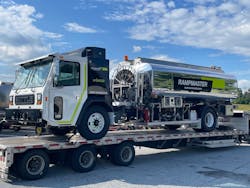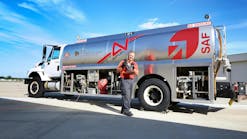Jet Refuelers Reduce Emissions with Electric Power Module
Whether fuel service providers are looking to invest in new electric ground support equipment (eGSE) or convert their diesel-powered refuelers to electric units, Rampmaster has developed a solution to assist its customers.
Earlier this year, Rampmaster introduced its first electric truck for refueling aircraft on-airport, the 5,000-gallon Rampmaster Jet Refueler. As for customers who have a diesel version of this refueler, they can swap the diesel power module with an electric module to produce zero emissions and achieve the economic benefits of an electric vehicle.
“Up until this point, we’ve been using diesel fuel to fuel everything on-airport,” says Kevin Ward, vice president and marketing, General Transervice / Rampmaster, adding a typical commuter operation will use 12 to 14 gallons of diesel a day. “A GA [general aviation] operation will use a lot less,” he says, “but that’s a lot in cost you’re just simply putting into the refueler tank.”
By comparison, he says, powering a refueling truck with a lithium-ion battery only requires a quick-charge, an hour and a half to two hours to fully charge. In a GA environment, Ward says the refueling vehicle would be continuously plugged in. Once a battery’s fully charged, it provides six to eight hours of fueling time.
“Everyone worries about how long the batteries will last due to our experience with phones and tablets. I have an electric vehicle and the batteries have degraded 1 percent per year since I have owned it. Our chassis manufacturer lists 1 percent a year for this product and many of my customers agree that is what they have seen on other lithium applications. In 10 years, that would be a 10 percent decline in battery output, not bad,” Ward says.
Overall maintenance on the electric module will be minimal, according to Rampmaster officials.
“We don’t expect there to be any maintenance done to this electric power module like you’d have on a typical diesel engine,” Ward says, adding the electric power module is actually locked down and bolted shut.
In total, Rampmaster refuelers consist of three modules. In addition to the power module, there are pump and tank modules. Ward says the truck’s pumping system and tank on the electric refueler are the standard modular design that Rampmaster has been using for years.
All three modules can individually be removed for repair, upgrade or overhaul and replaced with an exchanged module. According to Rampmaster officials, the modular design can more than double the life of a refueler. Because the pump and tank modules are “passive and resist wearing out,” the power module can be swapped out with another power module, while the pump and tank modules (two-thirds of the truck) remain in place.
“With the modular Rampmaster,we will be able to re-chassis your refueler to an electric version in the future,” Ward says. “This Rampmaster will have a new unit warranty with all of the benefits of electric.”
Another unique feature Rampmaster offers is its Engine Management (Flow Control) System (EMS), which means dozens of maintenance-prone parts aren’t needed. By eliminating many of the maintenance-intensive parts with EMS, the system is simplified, which Ward says is a benefit to an industry that often has high employee turnover.
EMS reduces the pump module to hoses, filter, meter and pipe, and sensors that are used to help maintain even pressure in the wing.
“About 12 years ago, we came out with engine management, and it used the engine to control the flow of the fuel, taking out a lot of the restriction that was in the pipe,” Ward says. “By doing that, we were able to drastically lower the RPMs. The electric unit will use electric management, it will do the same thing with the same piping system and it’s going to slow down those revolutions of that electric motor. This will be the most efficient electric when it comes to refueling (out there). A typical fuel truck will pump at its highest RPM and only deliver to the aircraft what it can take. This particular truck, the way it’s set up, will do the same thing only it will slow down that electric motor, and in doing so, it’s going to extend those charge times.”
Telematics continually monitor the refueler to make sure the refueler is in fit shape, Ward adds. The digital dashboard from chassis manufacturer Battle Motors also includes service and parts intelligence and an advanced driver assistance system.
In addition to monitoring efficiency, EMS is used to monitor safety.
“The display will indicate most of the safety systems on the Rampmaster, shutting down the pumping system when necessary,” Ward says.
Most of the standard features for general aviation and commercial aviation are available for the 5,000-gallon Rampmaster Jet Refueler, he says, adding the company can adapt to a customer’s needs.
Refuelers manufactured by Rampmaster range from 3,000 to 17,500 gallons. An electric version of Rampmaster’s 10,000- and 7,000-gallon refuelers have already been designed.
“We are still working out the specifics and looking forward to a future deployment,” says Ward.
“The 5,000-gallon capacity is considered the standard in refueling at most airports for general aviation and commuter operations; 10,000/15,000 and 17,500 are the workhorses of the commercial side of the business,” he adds.
In 1985, when Ward started in the industry, he says most of the general aviation traffic was fueled with 3,000-gallon capacity trucks. But as aircraft changed, so did the required fuel truck capacity.
“In the early ’90s the 5,000 became more popular, now 7,000-gallon capacity is becoming more popular, as the size and fueling capacity of jet aircraft have changed,” Ward says.
If considering an electric refueler, Ward suggests service providers consider the savings of fuel, the maintenance savings and funding that is available towards the purchase or lease of a refueler.







